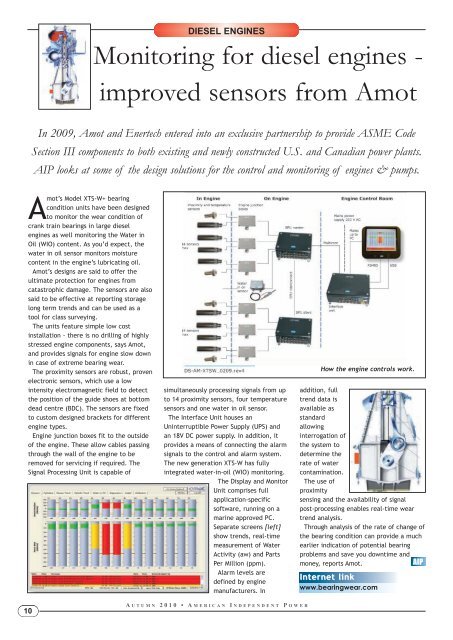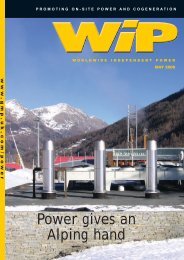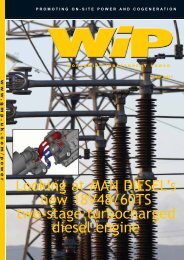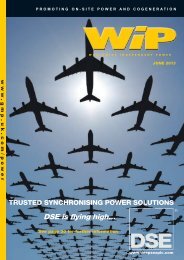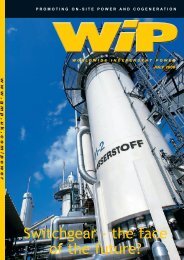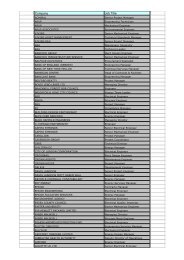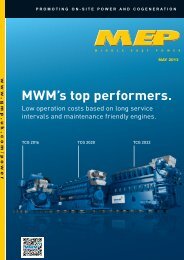Deep Sea Electronics - making groundbreaking technology which is ...
Deep Sea Electronics - making groundbreaking technology which is ...
Deep Sea Electronics - making groundbreaking technology which is ...
You also want an ePaper? Increase the reach of your titles
YUMPU automatically turns print PDFs into web optimized ePapers that Google loves.
DIESEL ENGINES<br />
Monitoring for diesel engines -<br />
improved sensors from Amot<br />
In 2009, Amot and Enertech entered into an exclusive partnership to provide ASME Code<br />
Section III components to both ex<strong>is</strong>ting and newly constructed U.S. and Canadian power plants.<br />
AIP looks at some of the design solutions for the control and monitoring of engines & pumps.<br />
Amot’s Model XTS-W+ bearing<br />
condition units have been designed<br />
to monitor the wear condition of<br />
crank train bearings in large diesel<br />
engines as well monitoring the Water in<br />
Oil (WIO) content. As you’d expect, the<br />
water in oil sensor monitors mo<strong>is</strong>ture<br />
content in the engine’s lubricating oil.<br />
Amot’s designs are said to offer the<br />
ultimate protection for engines from<br />
catastrophic damage. The sensors are also<br />
said to be effective at reporting storage<br />
long term trends and can be used as a<br />
tool for class surveying.<br />
The units feature simple low cost<br />
installation - there <strong>is</strong> no drilling of highly<br />
stressed engine components, says Amot,<br />
and provides signals for engine slow down<br />
in case of extreme bearing wear.<br />
The proximity sensors are robust, proven<br />
electronic sensors, <strong>which</strong> use a low<br />
intensity electromagnetic field to detect<br />
the position of the guide shoes at bottom<br />
dead centre (BDC). The sensors are fixed<br />
to custom designed brackets for different<br />
engine types.<br />
Engine junction boxes fit to the outside<br />
of the engine. These allow cables passing<br />
through the wall of the engine to be<br />
removed for servicing if required. The<br />
Signal Processing Unit <strong>is</strong> capable of<br />
simultaneously processing signals from up<br />
to 14 proximity sensors, four temperature<br />
sensors and one water in oil sensor.<br />
The Interface Unit houses an<br />
Uninterruptible Power Supply (UPS) and<br />
an 18V DC power supply. In addition, it<br />
provides a means of connecting the alarm<br />
signals to the control and alarm system.<br />
The new generation XTS-W has fully<br />
integrated water-in-oil (WIO) monitoring.<br />
The D<strong>is</strong>play and Monitor<br />
Unit compr<strong>is</strong>es full<br />
application-specific<br />
software, running on a<br />
marine approved PC.<br />
Separate screens [left]<br />
show trends, real-time<br />
measurement of Water<br />
Activity (aw) and Parts<br />
Per Million (ppm).<br />
Alarm levels are<br />
defined by engine<br />
manufacturers. In<br />
How the engine controls work.<br />
addition, full<br />
trend data <strong>is</strong><br />
available as<br />
standard<br />
allowing<br />
interrogation of<br />
the system to<br />
determine the<br />
rate of water<br />
contamination.<br />
The use of<br />
proximity<br />
sensing and the availability of signal<br />
post-processing enables real-time wear<br />
trend analys<strong>is</strong>.<br />
Through analys<strong>is</strong> of the rate of change of<br />
the bearing condition can provide a much<br />
earlier indication of potential bearing<br />
problems and save you downtime and<br />
money, reports Amot.<br />
AIP<br />
Internet link<br />
www.bearingwear.com<br />
10<br />
A UTUMN 2010 • AMERICAN I NDEPENDENT P OWER


